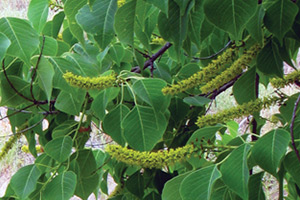
Scientific name: Triadica sebifera
Synonyms: Sapium sebiferum
Origin: China, Japan [5 &13].
Plant Description: The ultimate height of the tree is generally 30 to 40 ft and occasionally 60 ft. Dirr[3] states that the national champion is/was 76 ft in height and was located in Polk County, TX. The leaves are about 3.5 to 7 cm (~1.4 to 2.8 in ) long and about as broad. They are abruptly acuminate1, broadly cuneate. The slender petioles are 2 to 5 cm (~ 0.8 to 2 in) long. The leaf looks much like a poplar leaf. The yellow-greenish floral displays are slender and generally 5 to 10 cm (~2 to 4 in) long. The male florets are located at the apex of the display while generally 1 to 5 female florets are located at the base of the inflorescence. The fruits are three segmented brownish capsules 1 to 1.5 cm (~0.4 to 0.6 in) across. The capsules open to expose the white waxy seeds which gives the species one of its common names, the popcorn tree. The leaves turn reddish to red in the fall.[3 & 9] The species is native to China and Japan [13].
Distribution: See map.[11]
Blooming period: Pellett[7] reports in the Houston, Texas area there is continual bloom for about six weeks beginning in early May. There individual trees are reported to flower for about two weeks. In Louisiana the species blooms in April and May with floral displays 4 to 5 inches long.[8] Occasionally in Louisiana it may bloom a second time with smaller floral displays[8]. Skinner and Mahler[2] seem to indicate that it blooms August to November in North Central Texas. Compared to other blooming dates in the literature however, this seems late to this author. Perhaps it represents a second blooming period as occurs in Louisiana.
Importance as a honey plant: Ayers and Harman[1] from their questionnaires found the species to be of some importance in Texas. Where the plant is plentiful, it can be quite a good honey plant (see honey potential below).
Honey potential: Pellett[7] reports honey yields of 60 to 100 pounds from the Houston, Texas area. Pollet[8], writing about Louisiana honey plants, states that it is “the number one source of a majority of the honey crop each year.” Harvey Lovell[6] cites L. A. M. Barnett, apparently from Eastern Texas, as indicating the average surplus is 75 to 100 lbs per colony, but in 1948 he produced 228 lbs per colony. The Lawrence Goltz[4] version of the Harvey Lovell manual[4] indicates that the average yields are 35 to 50 lbs per colony in Texas.
Honey: Pellett[7] reports the honey to be amber in color with a mild though excellent flavor. In Louisiana the honey is considered …
Photo Caption
Photo of Triadica sebifera in flower. © Dwain Goforth. Be sure to notice the spectacular floral displays.


